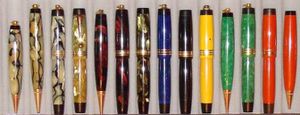Differenze tra le versioni di "Parker/en"
m |
|||
| (93 versioni intermedie di 2 utenti non mostrate) | |||
| Riga 1: | Riga 1: | ||
| − | [[Image:Logo-Parker.svg|center|300px|Logo | + | {{DEFAULTCATEGORYSORT:Parker}}[[Image:Logo-Parker.svg|center|300px|Parker Logo]] |
| + | [[Parker]] is one of the few American historical fountain pens brand remained continuously active to this day. ''The Parker Pen Company'' was founded by ''George Safford Parker'' in 1888 in Janesville, Wisconsin. Today the company is owned by [http://en.wikipedia.org/wiki/Sanford_%28writing_products%29 Sanford], a division of [http://en.wikipedia.org/wiki/Newell_Rubbermaid Newell Rubbermaid] that also owns [[Waterman]]. | ||
| − | [[Parker]] | + | Although the company always produced good quality fountain pens, [[Parker]] golden age goes from the '20s to '60s, when the company has distinguished itself for its great innovation capacity, obtaining always strong success. Thanks also to the creation of a vast network of branch offices (Canada, England, Denmark, France, Mexico, and Argentina), the company always maintained top rankings in worldwide sales of fountain pens, and was successful also in the ballpoint pen era. Together with [[Sheaffer]], [[Waterman]] and [[Wahl-Eversharp]] is a recognized member of the [[Big Four]].{{Infobox_Brand|Parker}}{{BrandData|Founder=George S. Parker|Date=1888|Place=Janesville, Wisconsin|Country=US}} |
| + | ==History== | ||
[[Image:Parker-Plant.jpg|thumb|[[Parker]] early plant]] | [[Image:Parker-Plant.jpg|thumb|[[Parker]] early plant]] | ||
| − | + | [[Parker]] was founded in Janesville in Wisconsin in [[1888]] by ''George Safford Parker'', which previously had operated as a reseller for the [[Holland|John Holland Pen Company]]. ''George Safford Parker'', who worked as a teacher of telegraphy, supplemented its income with the trade in fountain pens. Having to repair the pens that he sold, it began to improve their functioning, and because the pens he changed worked better than the original and had success, he decided to found his own company. | |
| − | + | [[Image:Parker-Overlay-Eyedropper-LuckyCurve-Open.jpg|thumb|left|Early ''[[Lucky Curve]]'']] | |
| − | [[ | + | He obtained his first patent ({{Cite patent|US|416944}}) in [[1889]], and a subsequent patent ({{Cite patent|US|512319}}) in [[1894]] for his special ''[[Lucky Curve]]'' feeder, which went back inside the pen with a special curved shape that is claimed to be able to call back the excess ink when the pen was not in use. In [[1891]] ''George Parker'' associated with ''William F. Palmer'', an insurer and they incorporated ''The Parker Pen Company'' in Janesville. |
| − | + | In fact, the ''"[[Lucky Curve]]"'' was simply a good feeder, which remained in production until [[1928]], and was used as a trademark for a number of pens, but there are doubts that the curved form actually had the effect to avoid the accumulation of ink, because much repairers cutted it, because the curved part makes it difficult to reinsert it between the nib and section. | |
| − | + | [[File:Parker-Snake-Silver-Capped.jpg|thumb|A rare [[Parker Snake]] ]] | |
| − | + | In the early years [[Parker]] began manufacturing good quality hard rubber pens. In this period it was famous for her silver overlay pens, and in particular for the [[Parker Snake|Snake]] pen with a snake shaped [[overlay]], that is sought after by collectors for its rarity, and for the [[Black Giant]] pen, characterized by a very large size. Another distinction point for [[Parker]] pens was the creation of [[button filler]], introduced in [[1913]] as reaction to the creation of the [[lever filler]], which was never been used in the company's flagship models, despite is diffusion between all the competitors of that time. | |
| − | |||
| − | |||
| − | |||
| − | In the early years [[Parker]] began manufacturing good quality | ||
[[Image:1922-11-Parker-Duofold-RHR.jpg|thumb|left|[[Duofold]] advertisement from '20s.]] | [[Image:1922-11-Parker-Duofold-RHR.jpg|thumb|left|[[Duofold]] advertisement from '20s.]] | ||
| − | [[Parker]] continued to produce | + | [[Parker]] continued to produce hard rubber pens with good results, focusing on the functionality of his pens and on the benefits of the [[button filler]], but the real breakthrough came in [[1921]] with the launch of [[Duofold]], which was a huge success, by getting the company at the top of sales. The creation of a large pen, made of hard rubber of a bright red color, was a revolution in the fountain pen world until then dominated by the black color, and foreshadowed the introduction of the celluloid colors by several years. |
| − | The success of the [[Duofold]], despite its price (10 dollars) was high for the time, continued for over a decade in which the models were revised several times, adjusting the production to the introduction of new materials such as celluloid or the new ''[[Streamlined]]'' style with tapered models. In 1923 was opened a plant in Canada, and was introduced a [[Duofold|Lady Duofold]] model for women. In 1926 also the [[Parker]] began to move production from | + | The success of the [[Duofold]], despite its price (10 dollars) was high for the time, continued for over a decade in which the models were revised several times, adjusting the production to the introduction of new materials such as celluloid or the new ''[[Streamlined]]'' style with tapered models. In [[1923]] was opened a plant in Canada, and was introduced a [[Duofold|Lady Duofold]] model for women. In [[1926]] also the [[Parker]] began to move production from hard rubber to celluloid. |
[[Image:Parker-Duofold-VestsPocket-Serie.jpg|thumb|All color for ''[[Vest pocket]]'' [[Duofold]].]] | [[Image:Parker-Duofold-VestsPocket-Serie.jpg|thumb|All color for ''[[Vest pocket]]'' [[Duofold]].]] | ||
| − | + | In [[1926]] was introduced an economic model, the [[Duofold|Parker DQ]], named such as ''Duofold Quality'' and at the end ofhe same year the company introduced also the [[Pastels]] models in pastel colors, as an alternative to the [[Duofold]] ladies models, sold at a lower price. But with the coming of Great Depression, the company was faced with a critical period. | |
| − | |||
| − | + | In [[1929]] the profits that were enormous suffered a steep fall, many producers failed and others had to sell off their pens at low prices. [[Parker]], that taken years to establish its brand, decided not to devalue his pens, and kept prices high for the [[Duofold]], but in order to compete in [[1932]] introduced a range of economic models, school-type, for which they did no advertising. These models did not have a name and are usually indicated by collectors as [[Thrift Time]], or ''[[Parker depression pen|depression pen]]''. | |
[[Image:1941-09-Parker-Vacumatic-Major.jpg|thumb|A [[Vacumatic]] advertisement of 1941.]] | [[Image:1941-09-Parker-Vacumatic-Major.jpg|thumb|A [[Vacumatic]] advertisement of 1941.]] | ||
| − | [[ | + | [[File:Parker-Vacumatic-3rdGen-Major-RingedBrown-Clip.jpg|left|thumb|100px|The [[Vacumatic]] arrow clip]] |
| − | + | The company, the had wisely piled stock in the good period, continued to invest in research, testing new materials and new filling systems, up to the realization, in 1933, of the wonderful [[Vacumatic]], with the arrow clip drawn from ''Joseph Platt'' (patent {{Cite patent|US|D088821}}, who has since then become the company symbol) with a transparent tank thanks to the [[Sistemi di caricamento#vacumatic|new filling system with the same name]]. The new pen reported the company at the top of the market. | |
| − | + | In [[1939]], following a trend initiated by [[Sheaffer]] with his ''[[White dot]]'' and followed by other brands, also [[Parker]] adopted a symbol to indicate the lifetime warranty, putting in the head of their pens clips the ''[[Blue diamond]]'', a small diamond in blue enamel. Unlike what happened for other brands the symbol was introduced late and for a relatively short period, going to disappear after a few years. | |
[[Image:BlueDiamond.jpg|thumb|left|150px|The ''[[Blue diamond]]'' for lifetime warranty.]] | [[Image:BlueDiamond.jpg|thumb|left|150px|The ''[[Blue diamond]]'' for lifetime warranty.]] | ||
| − | + | Despite the commercial success and the good technical quality of its pens, the [[Parker]] continued to invest heavily in research and innovation, and in [[1941]] introduced a revolutionary model, the [[51]], between the first pens made of plastic (''[[Lucite]]'') with a characteristic [[hooded nib]], which is necessary for the use of a new quick drying ink (the ''[[Superchrome Ink]]''), which tended to degrade the celluloid. The pen, although could not be considered particularly beautiful, and despite being built in ordinary plastic, was a tremendous success, and is probably the most sold fountain model of all time. | |
| − | |||
| − | |||
| − | + | The [[51]] had a number of changes in the following years, such as switching in [[1948]] to a new the filling system called ''[[aerometric]]'', the creation of different versions, including some luxury models in precious metals or with complex decorations for the metal cap. Some of these are extremely rare and highly sought after by collectors. | |
| − | + | In the following years the [[Parker]] continued introducing of new models and new technologies as the unique capillary filler of the [[61]] model, or the realization of [[T1]] model in titanium. The company was active in the fountain pen market with luxury and economic models, and at the same time achieved great successes in the production of the new ballpoint pens. | |
| − | + | The [[Parker]] is always remained active in the market, although since 1976 the company obtained more profit by the temporary employment agency Manpower than from the sale of pens. In 1993 the pen production division was acquired by [http://en.wikipedia.org/wiki/Gillette_Company Gillette Company], which already owned the Paper Mate. In 2000, Gillette gave the division the writing instruments [http://en.wikipedia.org/wiki/Newell_Rubbermaid Newell Rubbermaid], which already owned the [[Waterman]]. | |
| − | |||
| − | |||
| − | |||
| − | |||
| − | |||
| − | |||
| − | |||
| − | |||
| − | |||
| − | |||
| − | |||
| − | |||
| − | |||
| − | |||
| − | |||
| − | |||
| − | |||
| − | |||
| − | |||
| − | |||
| − | |||
| − | |||
| − | |||
| − | |||
| − | |||
| − | |||
| − | |||
| − | |||
| − | |||
| − | |||
| − | |||
| − | |||
| − | |||
| − | |||
| − | |||
| − | |||
| − | |||
| − | |||
| − | |||
| − | |||
| − | |||
| − | |||
| − | |||
| − | |||
| − | |||
| − | |||
| − | |||
| − | |||
| − | |||
| − | |||
| − | |||
| − | |||
| − | |||
| − | |||
| − | |||
| − | |||
| − | |||
| − | |||
| − | |||
| − | |||
| − | |||
| − | |||
| − | |||
| − | |||
| − | |||
| − | |||
| − | |||
| − | |||
| − | |||
| − | |||
| − | |||
| − | |||
| − | |||
| − | |||
| − | |||
| − | |||
| − | |||
| − | |||
| − | |||
| − | |||
| − | |||
| − | |||
| − | |||
| − | |||
| − | |||
| − | |||
| − | |||
| − | |||
| − | |||
| − | |||
| − | |||
| − | |||
| − | |||
| − | |||
| − | |||
| − | |||
| − | |||
| − | |||
| − | |||
| − | |||
| − | |||
| − | |||
| − | |||
| − | |||
| − | + | {{BrandChrono|Parker}} | |
| − | {{ | ||
| − | |||
| − | |||
| − | |||
| − | |||
| − | |||
| − | ==External | + | ==External references== |
| + | * [http://www.parkerpens.net] A website dedicated to [[Parker]], probably the best resource on the brand | ||
| + | * [http://web.archive.org/web/20091120220856/http://barnyard.syr.edu/~vefatica/pens.html] Vincent Fatica page, with interesting informations | ||
| + | * [http://www.penhero.com/PenGallery/Parker/Parker.htm] Parker chronology from Jim Mamoulides website | ||
| + | * [http://en.wikipedia.org/wiki/The_Parker_Pen_Company] Wikipedia page on [[Parker]] | ||
| + | * [http://www.vacumania.com/] Seller website, some info on [[Vacumatic]] | ||
| + | * [https://web.archive.org/web/20171219143146/http://www.rickconner.net/penspotters/parker.html] ''Penspotters'' page on [[Parker]] | ||
| + | * [https://web.archive.org/web/20140415063123/http://www.rickconner.net/penoply/park.0.html] ''Penoply'' page on [[Parker]] | ||
| + | * [http://web.archive.org/web/20090309234438/http://www.sovereign-publications.com/parkerpen.htm] An article on the brand | ||
| + | * [http://www.youtube.com/watch?v=T9hOhAXaFp4&feature=related] Historical film on '40s production | ||
| + | * [https://web.archive.org/web/20080704183056/http://www.mkpens.co.uk/parker_duofold_profile.htm] A [[Duofold Aerometric]] profile | ||
| + | * [http://stylosparker.over-blog.com/] Collector website, nice photos | ||
| + | * [http://www.atquid.com/viewArticle.php?article_id=53&title=The_Parker_Pen_Company] An article on company history | ||
| + | * [http://www.parkerpen.com] Official website, just advertising | ||
| + | ==Note== | ||
| + | <references/> | ||
| − | + | {{CategorizeBrand|U.S.A.}} | |
| − | |||
| − | |||
| − | |||
| − | |||
| − | |||
| − | |||
| − | |||
| − | |||
| − | |||
| − | |||
| − | |||
| − | |||
Versione attuale delle 10:37, 10 apr 2024
Parker is one of the few American historical fountain pens brand remained continuously active to this day. The Parker Pen Company was founded by George Safford Parker in 1888 in Janesville, Wisconsin. Today the company is owned by Sanford, a division of Newell Rubbermaid that also owns Waterman.
Although the company always produced good quality fountain pens, Parker golden age goes from the '20s to '60s, when the company has distinguished itself for its great innovation capacity, obtaining always strong success. Thanks also to the creation of a vast network of branch offices (Canada, England, Denmark, France, Mexico, and Argentina), the company always maintained top rankings in worldwide sales of fountain pens, and was successful also in the ballpoint pen era. Together with Sheaffer, Waterman and Wahl-Eversharp is a recognized member of the Big Four.
| Parker |
|---|
| Brand pages |
| Brand advertising |
| Brand photos |
| Instructions sheet |
| Patents |
History
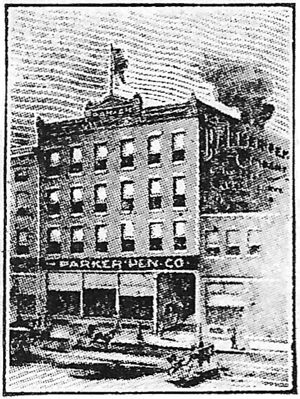
Parker was founded in Janesville in Wisconsin in 1888 by George Safford Parker, which previously had operated as a reseller for the John Holland Pen Company. George Safford Parker, who worked as a teacher of telegraphy, supplemented its income with the trade in fountain pens. Having to repair the pens that he sold, it began to improve their functioning, and because the pens he changed worked better than the original and had success, he decided to found his own company.

He obtained his first patent (nº US-416944) in 1889, and a subsequent patent (nº US-512319) in 1894 for his special Lucky Curve feeder, which went back inside the pen with a special curved shape that is claimed to be able to call back the excess ink when the pen was not in use. In 1891 George Parker associated with William F. Palmer, an insurer and they incorporated The Parker Pen Company in Janesville.
In fact, the "Lucky Curve" was simply a good feeder, which remained in production until 1928, and was used as a trademark for a number of pens, but there are doubts that the curved form actually had the effect to avoid the accumulation of ink, because much repairers cutted it, because the curved part makes it difficult to reinsert it between the nib and section.
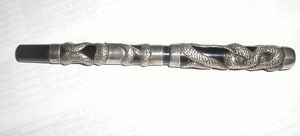
In the early years Parker began manufacturing good quality hard rubber pens. In this period it was famous for her silver overlay pens, and in particular for the Snake pen with a snake shaped overlay, that is sought after by collectors for its rarity, and for the Black Giant pen, characterized by a very large size. Another distinction point for Parker pens was the creation of button filler, introduced in 1913 as reaction to the creation of the lever filler, which was never been used in the company's flagship models, despite is diffusion between all the competitors of that time.
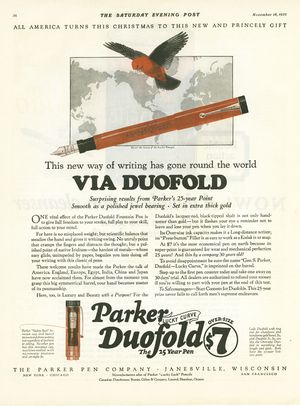
Parker continued to produce hard rubber pens with good results, focusing on the functionality of his pens and on the benefits of the button filler, but the real breakthrough came in 1921 with the launch of Duofold, which was a huge success, by getting the company at the top of sales. The creation of a large pen, made of hard rubber of a bright red color, was a revolution in the fountain pen world until then dominated by the black color, and foreshadowed the introduction of the celluloid colors by several years.
The success of the Duofold, despite its price (10 dollars) was high for the time, continued for over a decade in which the models were revised several times, adjusting the production to the introduction of new materials such as celluloid or the new Streamlined style with tapered models. In 1923 was opened a plant in Canada, and was introduced a Lady Duofold model for women. In 1926 also the Parker began to move production from hard rubber to celluloid.
In 1926 was introduced an economic model, the Parker DQ, named such as Duofold Quality and at the end ofhe same year the company introduced also the Pastels models in pastel colors, as an alternative to the Duofold ladies models, sold at a lower price. But with the coming of Great Depression, the company was faced with a critical period.
In 1929 the profits that were enormous suffered a steep fall, many producers failed and others had to sell off their pens at low prices. Parker, that taken years to establish its brand, decided not to devalue his pens, and kept prices high for the Duofold, but in order to compete in 1932 introduced a range of economic models, school-type, for which they did no advertising. These models did not have a name and are usually indicated by collectors as Thrift Time, or depression pen.
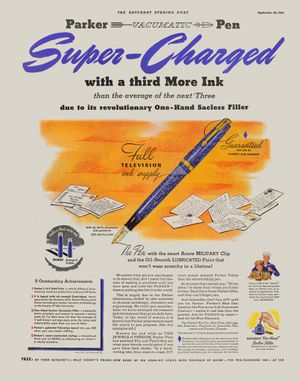

The company, the had wisely piled stock in the good period, continued to invest in research, testing new materials and new filling systems, up to the realization, in 1933, of the wonderful Vacumatic, with the arrow clip drawn from Joseph Platt (patent nº US-D088821, who has since then become the company symbol) with a transparent tank thanks to the new filling system with the same name. The new pen reported the company at the top of the market.
In 1939, following a trend initiated by Sheaffer with his White dot and followed by other brands, also Parker adopted a symbol to indicate the lifetime warranty, putting in the head of their pens clips the Blue diamond, a small diamond in blue enamel. Unlike what happened for other brands the symbol was introduced late and for a relatively short period, going to disappear after a few years.
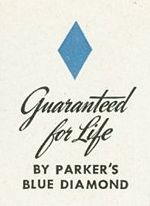
Despite the commercial success and the good technical quality of its pens, the Parker continued to invest heavily in research and innovation, and in 1941 introduced a revolutionary model, the 51, between the first pens made of plastic (Lucite) with a characteristic hooded nib, which is necessary for the use of a new quick drying ink (the Superchrome Ink), which tended to degrade the celluloid. The pen, although could not be considered particularly beautiful, and despite being built in ordinary plastic, was a tremendous success, and is probably the most sold fountain model of all time.
The 51 had a number of changes in the following years, such as switching in 1948 to a new the filling system called aerometric, the creation of different versions, including some luxury models in precious metals or with complex decorations for the metal cap. Some of these are extremely rare and highly sought after by collectors.
In the following years the Parker continued introducing of new models and new technologies as the unique capillary filler of the 61 model, or the realization of T1 model in titanium. The company was active in the fountain pen market with luxury and economic models, and at the same time achieved great successes in the production of the new ballpoint pens.
The Parker is always remained active in the market, although since 1976 the company obtained more profit by the temporary employment agency Manpower than from the sale of pens. In 1993 the pen production division was acquired by Gillette Company, which already owned the Paper Mate. In 2000, Gillette gave the division the writing instruments Newell Rubbermaid, which already owned the Waterman.
Chronology
| Year | Event |
|---|---|
| 1888 | the company is founded by George S. Parker in Janesville, Wisconsin |
| 1889 | George S. Parker begin to make fountain pens |
| 1891 | George S. Parker begin a partnership with William F. Palmer |
| 1892 | the company is incorporated as The Parker Pen Company |
| 1894 | the company patents (nº US-512319) the "Lucky Curve" feeder |
| 1898 | the company patents the slip-on cap |
| 1899 | the company patents (nº US-622256 and nº US-635700) the Jointless Pen |
| 1900 | the company introduces the gold filigree Lucky Curve |
| 1903 | Christian Olsen sign an agreement with Parker for their pens distribution |
| 1904 | the company introduces a first filling system based on rubber sac squeezing |
| 1905 | the company patents (nº US-778997) the spear-head feeder |
| 1906 | the company introduces the Emblem Pen |
| 1907 | the company introduces the Parker Snake |
| 1909 | the company introduces the Red Giant |
| 1909 | the company patent the "Jack Knife" cap and introduces the Jack Knife Safety[1] |
| 1910 | the company starts local production of Parker pens |
| 1911 | the company patents (nº US-990288) an improved Lucky Curve feeder, named spear-head |
| 1913 | the company introduces a gold ring at the cap top for women's models |
| 1913 | the company introduces the button filler |
| 1914 | the company introduces the Black Giant |
| 1916 | the company produces the Trench Pen for the U. S. War Department, given to soldiers to write from the front line |
| 1916 | the company introduces the Ivorine |
| 1916 | the company patents (nº US-1197224) the washer clip |
| 1917 | the company retires the Red Giant |
| 1918 | Cross became producer for Parker mechanical pencils |
| 1918 | the company retires the Trench Pen |
| 1920 | the company start producing mechanical pencils |
| 1921 | the company introduces the Duofold |
| 1921 | the company retires the Black Giant |
| 1922 | the company introduces the smaller size models Duofold Jr. and Lady Duofold |
| 1922 | the company introduces the models Duofold Deluxe with the metal band at the cap edge |
| 1925 | the company introduces the Black-tipped Jade first celluloid models |
| 1925 | the company retires the Ivorine |
| 1926 | the company converts all production to celluloid, starting from Duofold |
| 1926 | the company introduces the Parker Pastels |
| 1927 | the company convert Duofold from raised to flush band |
| 1928 | the company introduces the True Blue |
| 1928 | the company introduces two rings on Duofold cap (three for the the De Luxe) |
| 1928 | Parker acquire Osmia for the european production |
| 1929 | the company retires the True Blue |
| 1929 | the company introduces the streamlined version of the Duofold |
| 1930 | the company introduces the vest pocket Duofold |
| 1930 | Parker retires from Osmia and the Osmia GmbH is founded |
| 1930 | the company introduces the Vest Pocket Duette model |
| 1931 | the company introduces the Burgundy Black Duofold |
| 1931 | the company introduces the Quink ink |
| 1932 | the company introduces the Parco |
| 1932 | the company introduces the Thrift Time |
| 1932 | the company introduces sample of the Golden Arrow, the Vacumatic forerunner |
| 1933 | the company introduces the Vacumatic |
| 1933 | the company retires the Thrift Time |
| 1933 | the company rename the Parco as Parkette |
| 1934 | the company restyles the Parkette introducing the De Luxe version |
| 1934 | the company introduces the Challenger |
| 1935 | the company introduces the Challenger De Luxe |
| 1935 | the company retires the Duofold that no longer appear in the catalogs[2] |
| 1936 | the company produces only for this year the Senior for Vacumatic |
| 1936 | the company introduces the Golden Web |
| 1937 | the company restyles the Challenger (and Challenger De Luxe) |
| 1937 | the company introduces the Speedline Vacumatic |
| 1937 | the company retires the Golden Web |
| 1937 | the company introduces the Royal Challenger |
| 1938 | the company introduces the Shadow Wave version of Vacumatic |
| 1939 | the company completed the Parker 51 development |
| 1939 | the company introduces the Blue Diamond life warranty |
| 1939 | the company introduces the Duofold Geometric |
| 1940 | the company introduces in South America and the Caribbean |
| 1940 | the company retires the Vacumatic Burgundy color |
| 1940 | the company introduces the Laidtone Duofold |
| 1940 | the company retires the Duofold Geometric |
| 1940 | the company retires the Parkette both normal and De Luxe version |
| 1941 | the company introduces and then retires the Parkette Zephyr |
| 1941 | the company retires the Challenger |
| 1941 | the company introduces the Parker 51 on the global market |
| 1941 | the company introduces the Vacumatic Maxima with round bottom |
| 1942 | the company retires the Shadow Wave Shadow Wave versions of Vacumatic |
| 1942 | the company introduces the mention of the Solv-X ingredient for Quink ink |
| 1942 | the company introduces the War time Vacumatic |
| 1946 | the company introduces the Duofold NS |
| 1946 | the company introduces the Red band filler on the Parker 51 |
| 1947 | the company retires the Red band filler on the Parker 51 |
| 1947 | the company introduces the Parker 51 Demi |
| 1947 | the company introduces the new 51 arrow clip |
| 1947 | the company introduces the Parker VS |
| 1948 | the company retires the Duofold NS |
| 1948 | the company retires the Vacumatic |
| 1948 | the company introduces the Parker 21 |
| 1948 | the company introduces the Superchrome Ink |
| 1948 | the company turns the 51 to the aerometric filler |
| 1948 | the company retires the Laidtone Duofold |
| 1949 | the company introduces the Parker 51 Flighter version |
| 1949 | the company retires the Parker VS |
| 1950 | the company reintroduces the Parkette |
| 1950 | the company introduces the Parker 51 Special |
| 1950 | the company introduces the Parker 41 |
| 1951 | the company retires the imprinting date code on USA produced Parker 51 |
| 1951 | the company retires the Parker 41 |
| 1952 | the company introduces the 21 Mark II |
| 1953 | the company retires stops imprinting date code on the Parker 51 produced outside the USA |
| 1953 | the company retires again the Parkette line |
| 1954 | the company introduces the Made in USA imprint on Parker 51 cap |
| 1956 | the company introduces the Parker 61 |
| 1956 | the company removes references to the Superchrome Ink on the Parker 51 filling system |
| 1956 | the company retires the Superchrome Ink |
| 1957 | the Eversharp writing instrument division is sold to Parker |
| 1960 | the company introduces the Parker 45 |
| 1961 | the company introduces the Parker 19 |
| 1962 | the company introduces the 19 second version |
| 1962 | the company introduces the 45 "Arrow" version |
| 1962 | the company introduces the 61 second version |
| 1962 | the company introduces the Parker VP |
| 1963 | the company retires the Parker 19 |
| 1964 | the company introduces the 45 "Flighter" version |
| 1964 | the company introduces the Parker 75 |
| 1965 | the company use a section with plastic threads on the 75 |
| 1965 | the company retires the Parker 21 |
| 1965 | the company retires the Parker VP |
| 1967 | the company introduces the 45 "Lady" version |
| 1967 | the company introduces the 45 "DeLuxe" version |
| 1967 | the company introduces the 45 "Coronet" version |
| 1968 | the company remove the 0 central mark on the 75 ring |
| 1970 | the company introduces the Parker T1 |
| 1971 | the company retires the Parker T1 |
| 1972 | the company retires the Parker 51 (date uncertain[3]) |
| 1972 | the company introduces dished ends on the 75 |
| 1979 | the company introduces the 45 "Harlequin 80" version |
| 1979 | the company introduces the 45 "TX" version |
External references
- [1] A website dedicated to Parker, probably the best resource on the brand
- [2] Vincent Fatica page, with interesting informations
- [3] Parker chronology from Jim Mamoulides website
- [4] Wikipedia page on Parker
- [5] Seller website, some info on Vacumatic
- [6] Penspotters page on Parker
- [7] Penoply page on Parker
- [8] An article on the brand
- [9] Historical film on '40s production
- [10] A Duofold Aerometric profile
- [11] Collector website, nice photos
- [12] An article on company history
- [13] Official website, just advertising
Note
- ↑ according to what is said in this page.
- ↑ as reported by Richard Binder on this page who also reports a subsequent production, demonstrated by the presence of a model with a 1938 dating code.
- ↑ we use the one indicated as official by Richard Binder in this article.

